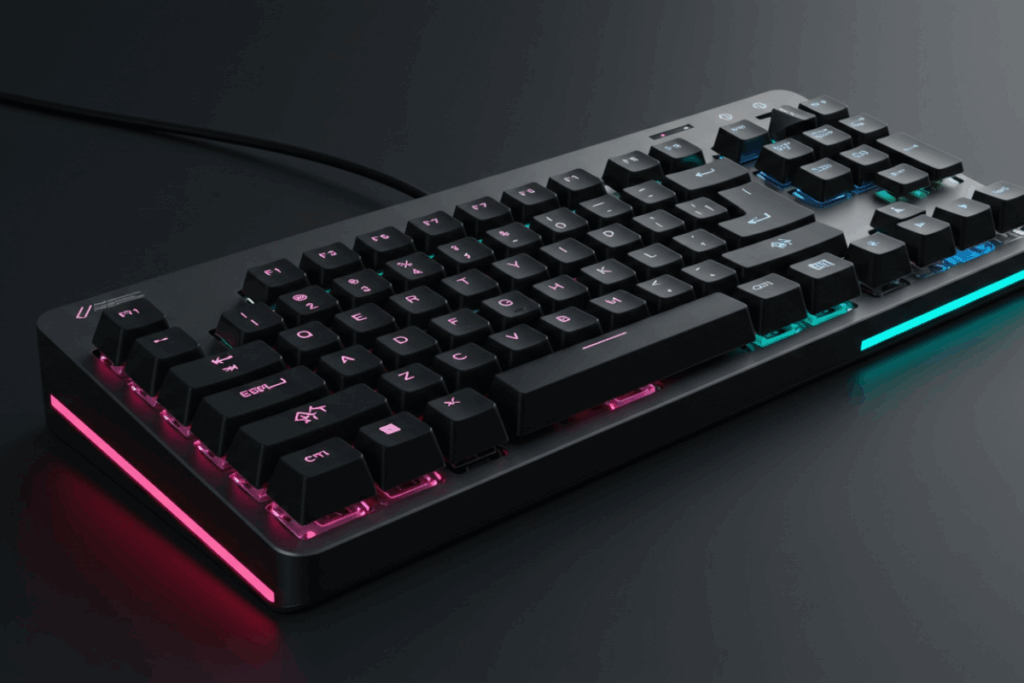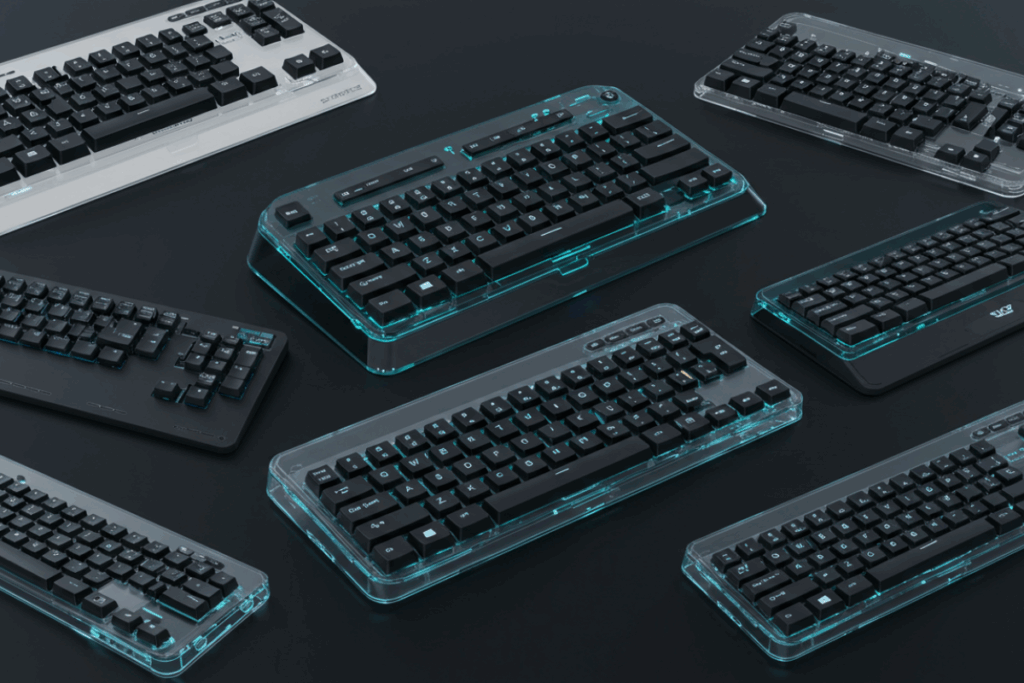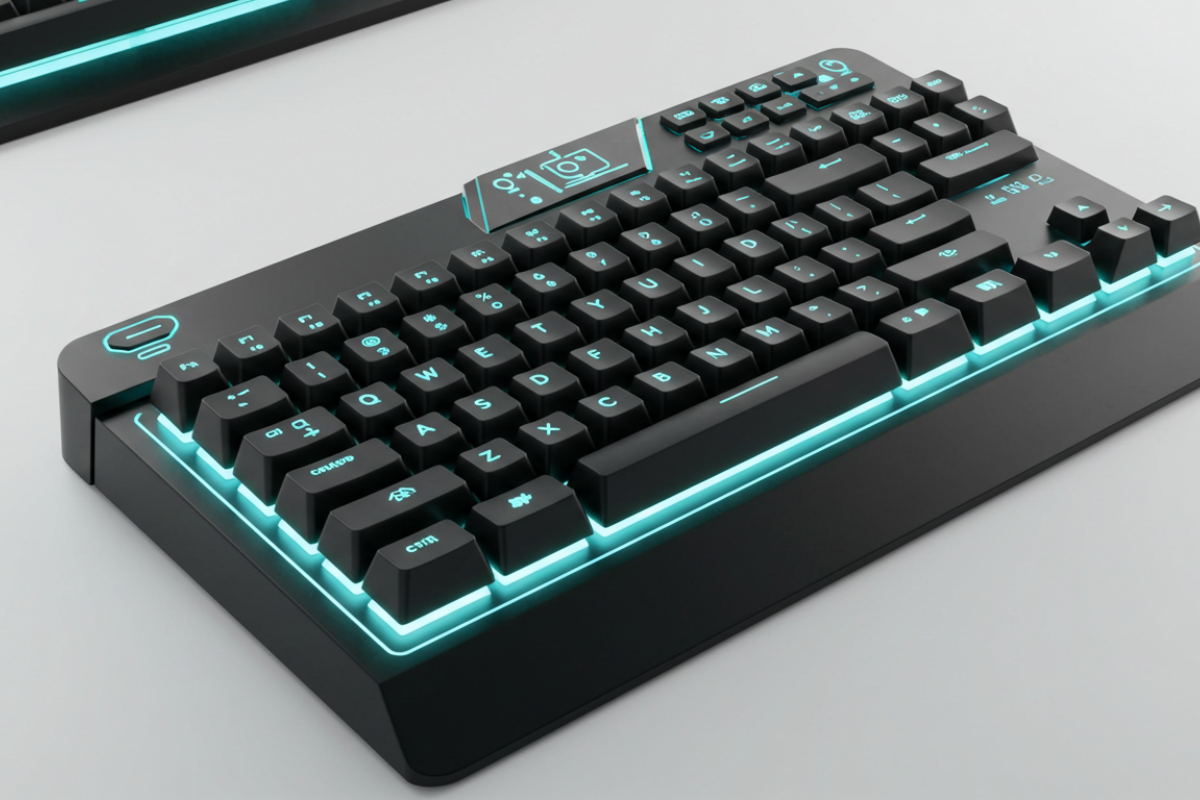futuristic keyboard designs are reshaping how I type and work. In this Keyboards Technology guide I cover AI adaptive keys, haptic feedback, modular split layouts, transparent OLED and flexible e‑ink panels, plus projected and gesture setups.
I explain who benefits — gamers, professionals, creatives, and mobile workers — and share simple checks for privacy, latency, force sensing, and accessibility. Read on and I’ll help you pick future‑proof gear that boosts speed, comfort, and control.
Futuristic keyboard designs — Key takeaway
- I prefer ultra‑thin boards with low‑force, hot‑swappable switches.
- I snap on magnetic modules (numpad, trackpad) when needed.
- I rely on per‑key displays and AI layouts that learn my shortcuts.
- Strong tactile feedback, adjustable actuation, and fast wireless matter for gaming and work.
- Foldable, repairable designs are travel‑friendly and built to last.
How I use AI adaptive keyboard features in futuristic keyboard designs
How AI adaptive keyboard helps my typing
I use AI to smooth typing rough edges. The keyboard learns my common typos and offers predictions that match my style, reducing corrections and preserving flow. It can adapt key feel and latency for fast bursts and suggest short phrases for email. Good on‑device models make suggestions feel natural and fast.
What I check for privacy in AI‑assisted input
Privacy is the first thing I check. I want my words to stay private.
| Check | Why it matters | What I do |
|---|---|---|
| Local processing | Keeps text on my device | Turn on local mode if available |
| Data collection policy | Shows what is sent off‑device | Read it and toggle off uploads |
| Encryption | Protects data in transit | Use encrypted sync or a VPN |
| Logs & retention | Limits stored history | Clear logs and set short retention |
| Permissions | Controls app access | Deny mic/camera if unrelated; limit keyboard access |
I scan settings immediately and keep cloud sync off until I verify the policy. I prefer models that let me run AI offline for peace of mind.
Quick setup steps I follow for AI adaptive keyboards
- Install the Keyboards Technology driver or app.
- Enable AI features in settings.
- Turn on local processing if offered.
- Disable cloud upload.
- Run a short calibration typing test.
- Save a profile (travel/office).
I then type a real‑world paragraph to spot odd suggestions or latency and tweak sensitivity or prediction depth.
Why I prefer a haptic feedback keyboard in futuristic keyboard designs
I test for Keyboards Technology and pick haptic models most days. They provide a clear, physical signal without loud switches — the quiet feedback improves speed and accuracy. For futuristic keyboard designs, haptics bridge quiet electronics and real key feel: subtle feedback in a modern, slim build.
How haptic feedback gives clear touch cues
A haptic pulse is short and precise, confirming registration and reducing second‑guessing. I use it for coding, gaming, and long typing sessions.
- Why it matters: hands flow instead of hunting keys.
- When I use it: long sessions, quiet offices, live streams.
| Cue type | What I feel | Why it helps |
|---|---|---|
| Short tap | Quick pulse at actuation | Confirms input without sound |
| Double pulse | Two ticks or stronger pulse | Macro layers or special modes |
| No pulse | Smooth glide | For silence‑critical typing |
What I check about force sensing and actuation
I test for consistent feel and predictable actuation.
- Actuation force: test where the key triggers — I like a middle range to avoid fatigue.
- Travel: short travel works well with clear haptic pulses.
- Latency: the pulse must coincide with registration. Delays break the illusion.
- Consistency: each key should behave the same.
| Metric | Typical range I watch | My target |
|---|---|---|
| Actuation force | 30–60 g | 40–50 g |
| Travel | 1.0–3.5 mm | 1.5–2.8 mm |
| Haptic latency | < 10 ms | < 5 ms |
Good firmware lets me tweak pulse strength and timing — Keyboards Technology often provides useful tuning options.
One test I run to feel haptic quality
- Sit blindfolded or look away.
- Press a key slowly until it actuates.
- Note when the haptic pulse vs registration occurs.
- Repeat across five keys.
- Do a short typing run checking consistency.
The pulse should land at actuation and be uniform across keys. I use phone slow‑motion to verify timing if needed.
How modular split keyboard layouts shape my comfort in futuristic keyboard designs
I want keyboards that fit my body. A modular split layout lets me place each half where my shoulders relax, which significantly reduced my wrist pain. Keyboards Technology builds parts that click together cleanly and last. Split boards feel like a custom tool — comfort that makes futuristic keyboard designs genuinely useful.
Hot‑swap features I want in a modular split keyboard
I swap switches weekly; hot‑swap saves time and money. A strong hot‑swap system must be sturdy and accessible.
- Per‑key hot‑swap — mix switch types.
- Top‑access sockets — swap without disassembly.
- Wide compatibility — MX‑style and low‑profile switches.
- Durable pins — survive many swaps.
| Feature | Why it matters | My preference |
|---|---|---|
| Per‑key hot‑swap | Try different feels | Yes |
| Top‑access | Faster swaps | Yes |
| Switch types | More typing/gaming options | MX low‑profile |
| Durability | Fewer failures | High‑quality pins |
Swapping a worn linear for a tactile in minutes refreshed long typing sessions and extended board life.

Tenting and position options I use to fix posture
Tenting fixed bent wrists. A small tent angles palms up, relaxing shoulders. I use several angles and hand positions.
| Angle | How I use it | Benefit |
|---|---|---|
| 0° (flat) | Quick edits, travel | Fast reach |
| 5–10° | Daily work | Less wrist strain |
| 15° | Long sessions | Reduced shoulder tension |
Separating halves opens my chest and prevents hunching. Thumb clusters reduce finger travel. Try one change at a time to find what helps.
Checklist for choosing a modular split keyboard
- Ergonomics first: adjustable tenting and split distance.
- Hot‑swap support: per‑key, top‑access sockets.
- Build quality: solid feel, snug connectors.
- Layout options: macro keys, row profiles, thumb clusters.
- Software: simple, stable programming.
- Brand trust: parts and support from Keyboards Technology.
I test a board for a week with email, coding, and gaming — if shoulders and wrists feel better, it earns a spot in my lineup.
Where transparent OLED and flexible e‑ink keyboards fit in futuristic keyboard designs
Transparent OLED and flexible e‑ink are two clear paths for futuristic keyboard designs. Each solves different problems: OLED for rich visuals and fast feedback; e‑ink for low power and sunlight readability. Keyboards Technology offers both, helping me pick the right tool.
What I notice about transparent OLED clarity
High contrast and rich color stand out. The glass surface feels premium, but bright sunlight and viewing angle can reduce visibility. Low‑quality panels show edge bleed. Per‑key animations and color cues help when switching layers.
Pros: excellent color and contrast, dynamic feedback, premium look.
Cons: sunlight visibility can drop, glare on glossy surfaces, edge bleed on cheaper panels.
Why I compare flexible e‑ink and OLED for power and visibility
They trade off power vs visibility.
| Feature | Flexible e‑ink keyboard | Transparent OLED keyboard |
|---|---|---|
| Power use | Very low; image persists | Higher; constant refresh backlight |
| Sunlight visibility | Excellent (matte) | Good but worse in direct sun |
| Color | Mostly grayscale | Full color & animation |
| Refresh / motion | Slow | Fast |
| Battery life | Days–weeks | Hours–day |
I choose e‑ink for long battery life and outdoor readability; OLED when I need rich visuals and fast feedback.
Visual tests I use to compare OLED panels
- Brightness sweep — watch for washout or color shift.
- Sunlight check — test readability and glare outside.
- Angle test — look for contrast loss from the side.
- Color block test — check uniformity and edge bleed.
- Typing motion test — watch for ghosting and refresh lag.
- Fingerprint check — see how visible smudges are and how easy cleaning is.
I test in a room and in a café to get realistic results.
How I try projected virtual keyboards and gesture‑controlled setups for futuristic keyboard designs
I test short sessions first and tweak one variable at a time. I use Keyboards Technology gear when possible.
How projected keyboard latency affects my typing
Latency kills rhythm. I type fast; even small delays cause pauses and mistakes.
| Latency (ms) | How it feels | My tip |
|---|---|---|
| 0–30 | Feels instant | Use for serious typing |
| 31–70 | Slight lag | Lower sensitivity/update rate |
| 71 | Noticeable lag | Use for casual input only |
I measure latency with a phone timer and short typing tests; moving the projector or changing settings often fixes lag.
How AR keyboard interfaces and gesture control work for me
AR keyboards feel like ghosts under my hands — keys in the air or on surfaces. Gestures are useful but must be simple.
What helps:
- High contrast visuals.
- Large hit areas for reliable taps.
- Simple gestures (swipe to delete, tap to select).
- Haptic feedback when possible.
I limit gestures during long typing sessions; for serious work I prefer projected keyboards. Both have their places in futuristic keyboard designs.
Simple calibration for projected systems
- Set projector height so keys appear flat.
- Adjust key size to fingertip width.
- Map the touch plane by tapping four corners.
If hits still miss, repeat corner taps and slightly increase sensitivity.
How biometric secure keyboards and dynamic braille keyboards improve access in futuristic keyboard designs
I test both types thoroughly. They remove barriers and add real value when reliable.
Biometric secure keyboard safety checks
Treat biometric keyboards like safe locks — failures expose data.
- Sensor accuracy: repeat scans for consistency.
- FAR / FRR: balance false acceptance and rejection rates.
- Data handling: verify encryption at rest and in transit.
- Latency: measure unlock time.
- Durability: simulate thousands of cycles.
| Check | What I look for | Why it matters |
|---|---|---|
| Sensor accuracy | Consistent reads | Prevents lockouts |
| FAR / FRR | Test numbers | Balance access & security |
| Data handling | Encrypted storage | Protects sensitive info |
| Latency | Quick response | Smooth experience |
| Durability | Wear over cycles | Long‑term reliability |
I log results and flag failures for vendor fixes. I prefer devices that pass these tests and feel solid in hand.
How dynamic braille keyboards help users
Dynamic braille keyboards change their surface to show braille dots and are invaluable for people who are blind or have low vision.
- Real‑time braille feedback lets users feel letters as they type.
- They reduce task time; typing and reading happen under the fingers.
- Surfaces adapt to apps (menus, text, controls).
- They replace separate braille displays: one device to type and read.
- Users report greater independence and confidence.
| Benefit | Real use |
|---|---|
| Faster typing | Immediate braille feedback |
| One device | Type and read without switching gear |
| App control | Menus as braille dots |
| Independence | Less outside help needed |
A teacher I assisted graded papers faster with a dynamic braille keyboard — it became a bridge between hands and screen.
Practical tips to test biometric reliability
- Three‑person check: owner two others; record acceptances/rejections.
- Day/night runs: test in bright and low light.
- Wet/dry fingers: mimic real‑world conditions.
- Stress cycles: run ~10,000 cycles and note failures.
- Data audit: request storage docs to confirm templates aren’t readable.
- Update test: apply firmware updates and retest.
| Test | What I record | Pass mark |
|---|---|---|
| Three‑person check | Accept/reject counts | <1% false accept |
| Day/night runs | Sensor variance | <2% change |
| Wet/dry fingers | Success rate | >95% |
| Stress cycles | Failures over cycles | No failures <10k |
| Data audit | Encryption proof | Encrypted templates |
| Update test | Performance before/after | Same performance |
If a keyboard passes, I add it to my preferred list at Keyboards Technology.
Top trends in futuristic keyboard designs
- Per‑key dynamic displays — labels and shortcuts change per app, improving productivity.
- AI‑driven layouts — keyboards that learn and rearrange for your most used shortcuts.
- Modular, repairable hardware — magnetic modules and replaceable parts for longevity.
- Low‑power materials — e‑ink and efficient controllers extend battery life for mobile workers.
- Advanced accessibility — integrated braille and biometric options expand usable scenarios.
These trends show that the best futuristic keyboard designs are practical: they save time, reduce strain, and extend device lifetimes.

Conclusion
I’ve covered what matters when choosing futuristic keyboard designs — AI adaptive keys, haptic feedback, modular split layouts, transparent OLED and flexible e‑ink panels, plus projected and gesture setups. Prioritize speed, comfort, privacy, and durability. Put ergonomics and latency first, then match display and power profiles to your life. Test haptics for timing — the pulse must land when the key registers. Favor local AI and clear data policies. Try hot‑swap and tenting early; small tweaks can transform comfort. For travel, pick repairable, foldable designs with strong battery life. For accessibility, back biometric security and dynamic braille when reliability is proven.
Think of these keyboards as tools in a well‑packed toolbox. The right one makes work effortless; the wrong one adds clutter. I pick gear that becomes invisible in use — a trusted clock that keeps my rhythm steady. For more hands‑on tips and real tests, visit https://marealtacharter.com.br/.
Frenquently asked questions
Q: What makes the futuristic keyboard designs you recommend different?
A: I choose Keyboards Technology for adaptive OLED keys, strong haptics, and modular builds — features that feel modern and last.
Q: Are futuristic keyboard designs reliable for fast typing?
A: Optical and magnetic switches from Keyboards Technology are fast. Projected pads are neat but usually slower for long typing.
Q: Can I customize futuristic keyboard designs from Keyboards Technology?
A: Yes — modules, key maps, and macros are swappable. Hot‑swap parts make upgrades easy.
Q: How long does the battery last on these futuristic keyboard designs?
A: With screens on I see 8–40 hours. With power saving, some setups stretch to weeks. Check vendor specs for exact numbers.
Q: Are futuristic keyboard designs worth the price?
A: If you want features and durability, yes. Keyboards Technology provides firmware updates and spare parts that matter long term.

